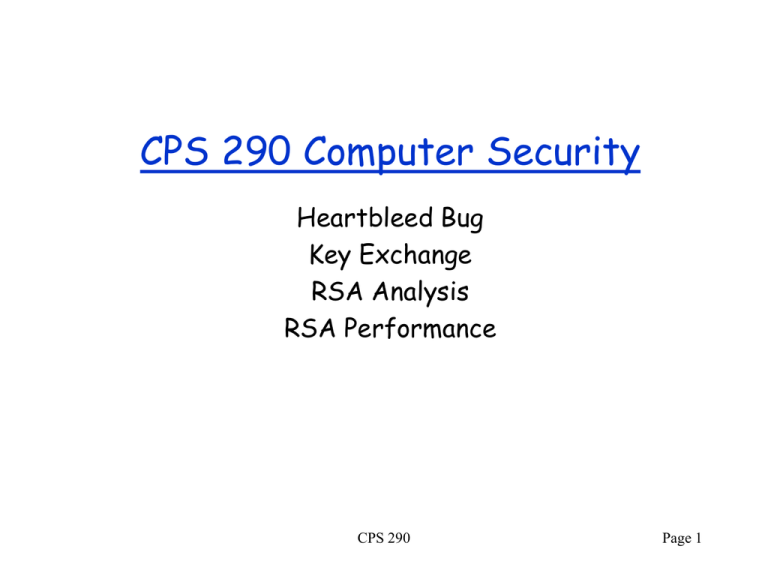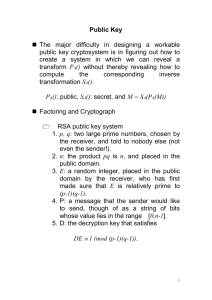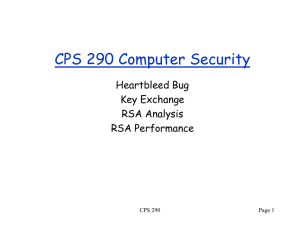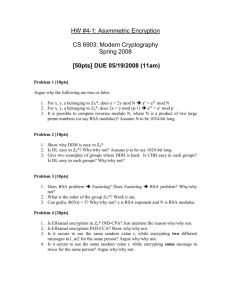CPS 290 Computer Security Heartbleed Bug Key Exchange RSA Analysis
advertisement

CPS 290 Computer Security
Heartbleed Bug
Key Exchange
RSA Analysis
RSA Performance
CPS 290
Page 1
OpenSSL “Heartbleed” Bug
Announced April, 2014.
Exploits a programming mistake in the OpenSSL implementation
of the TLS ``heartbeat hello’’ extension.
Heartbeat protocol is used to keep a TLS connection alive
without continuously transferring data.
One endpoint (e.g., a Web browser) sends a HeartbeatRequest
message containing a payload to the other endpoint (e.g. a
Web server). The server then sends back a HeartbeatReply
message containing the same payload.
“Buffer over-read” error caused by a failure to check for an
invalid read-length parameter.
CPS 290
Page 2
From RFC 6520
Heartbeat Request and Response Messages
The Heartbeat protocol messages consist of their type and an arbitrary
payload and padding.
Problem: no check that
payload_length matches the
actual length of the payload
struct {
HeartbeatMessageType type;
uint16 payload_length;
opaque payload[HeartbeatMessage.payload_length];
opaque padding[padding_length];
} HeartbeatMessage;
The total length of a HeartbeatMessage MUST NOT exceed 2^14 or
max_fragment_length when negotiated as defined in [RFC6066].
type: The message type, either heartbeat_request or heartbeat_response.
payload_length: The length of the payload.
payload: The payload consists of arbitrary content.
padding: The padding is random content that MUST be ignored by the receiver.
CPS 290
Page 3
Heartbleed Vulnerability
RSA private keys p, q, p-1, q-1, d can be extracted by the
attacker, as can anything else in the right portion of server
memory, such as passwords.
All Web sites using OpenSSL (e.g., using Apache, nginx servers)
should have their certificates revoked, and new certificates
issued.
Akamai was informed before the bug was announced publicly
and released a patch, but (oops!) there was a bug in that too.
Widely agreed to be a catastrophic security failure.
CPS 290
Page 4
Diffie-Hellman Key Exchange
A group (G,*) and a primitive element (generator) g is
made public.
– Alice picks a, and sends ga to Bob
– Bob picks b and sends gb to Alice
– The shared key is gab
Note this is easy for Alice or Bob to compute, but
assuming discrete logs are hard is hard for anyone
else to compute.
Can someone see a problem with this protocol?
CPS 290
Page 5
Person-in-the-middle attack
ga
Alice
gc
Mallory
gd
Bob
gb
Key1 = gad
Key1 = gcb
Mallory gets to listen to everything.
CPS 290
Page 6
RSA
Invented by Rivest, Shamir and Adleman in 1978
Based on difficulty of factoring.
Used to hide the size of a group Zn* since:
*n (n) n (1 1/ p)
p| n
Factoring has not been reduced to RSA
– an algorithm that generates m from c does not
give an efficient algorithm for factoring
On the other hand, factoring has been reduced to
finding the private-key.
– there is an efficient algorithm for factoring
given one that can find the private key.
CPS 290
Page 7
RSA Public-key Cryptosystem
What we need:
• p and q, primes of
approximately the
same size
• n = pq
(n) = (p-1)(q-1)
• e Z (n)*
• d = inv. of e in Z (n)*
i.e., d = e-1 mod (n)
Public Key: (e,n)
Private Key: d
Encode:
m Zn
E(m) = me mod n
Decode:
D(c) = cd mod n
CPS 290
Page 8
RSA continued
Why it works:
D(c) = cd mod n
= med mod n
= m1 + k(p-1)(q-1) mod n
= m1 + k (n) mod n
= m(m (n))k mod n
= m (because (n) = 0 mod (n))
Why is this argument not quite sound?
What if m Zn* then m(n) 1 mod n
Answer 1: Not hard to show that it still works.
Answer 2: jackpot – you can factor n using Euclid’s alg.
CPS 290
Page 9
RSA computations
To generate the keys, we need to
– Find two primes p and q. Generate candidates
and use primality testing to filter them.
– Find e-1 mod (p-1)(q-1). Use Euclid’s
algorithm. Takes time log2(n)
To encode and decode
– Take me or cd. Use the power method.
Takes time log(e) log2(n) and log(d) log2(n) .
In practice e is selected to be small so that encoding
is fast.
CPS 290
Page 10
Security of RSA
Warning:
– Do not use this or any other algorithm naively!
Possible security holes:
– Need to use “safe” primes p and q. In particular p1 and q-1 should have large prime factors.
– p and q should not have the same number of digits.
Can use a middle attack starting at sqrt(n).
– e cannot be too small
– Don’t use same n for different e’s.
– You should always “pad”
CPS 290
Page 11
RSA Performance
Performance: (600Mhz PIII) (from: ssh toolkit):
Algorithm
Bits/key
Mbits/sec
1024
.35sec/key
2048
2.83sec/key
1024
1786/sec
3.5
2048
672/sec
1.2
1024
74/sec
.074
2048
12/sec
.024
ElGamal Enc.
1024
31/sec
.031
ElGamal Dec.
1024
61/sec
.061
RSA Keygen
RSA Encrypt
RSA Decrypt
DES-cbc
56
95
twofish-cbc
128
140
Rijndael
128
180
CPS 290
Page 12
RSA in the “Real World”
Part of many standards: PKCS, ITU X.509,
ANSI X9.31, IEEE P1363
Used by: SSL, PEM, PGP, Entrust, …
The standards specify many details on the
implementation, e.g.
– e should be selected to be small, but not too
small
– “multi prime” versions make use of n = pqr…
this makes it cheaper to decode especially in
parallel (uses Chinese remainder theorem).
CPS 290
Page 13
Factoring in the Real World
Quadratic Sieve (QS):
T ( n) e
(1 o ( n ))(ln n )1 / 2 (ln(ln n ))1 / 2
– Used in 1994 to factor a 129 digit (428-bit)
number. 1600 Machines, 8 months.
Number field Sieve (NFS):
T ( n) e
(1.923 o (1))(ln n )1 / 3 (ln(ln n ))2 / 3
– Used in 1999 to factor 155 digit (512-bit) number.
35 CPU years. At least 4x faster than QS
– Used in 2003-2005 to factor 200 digits (663 bits)
75 CPU years ($20K prize)
CPS 290
Page 14




